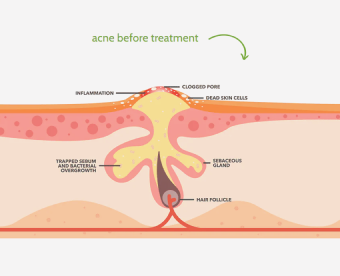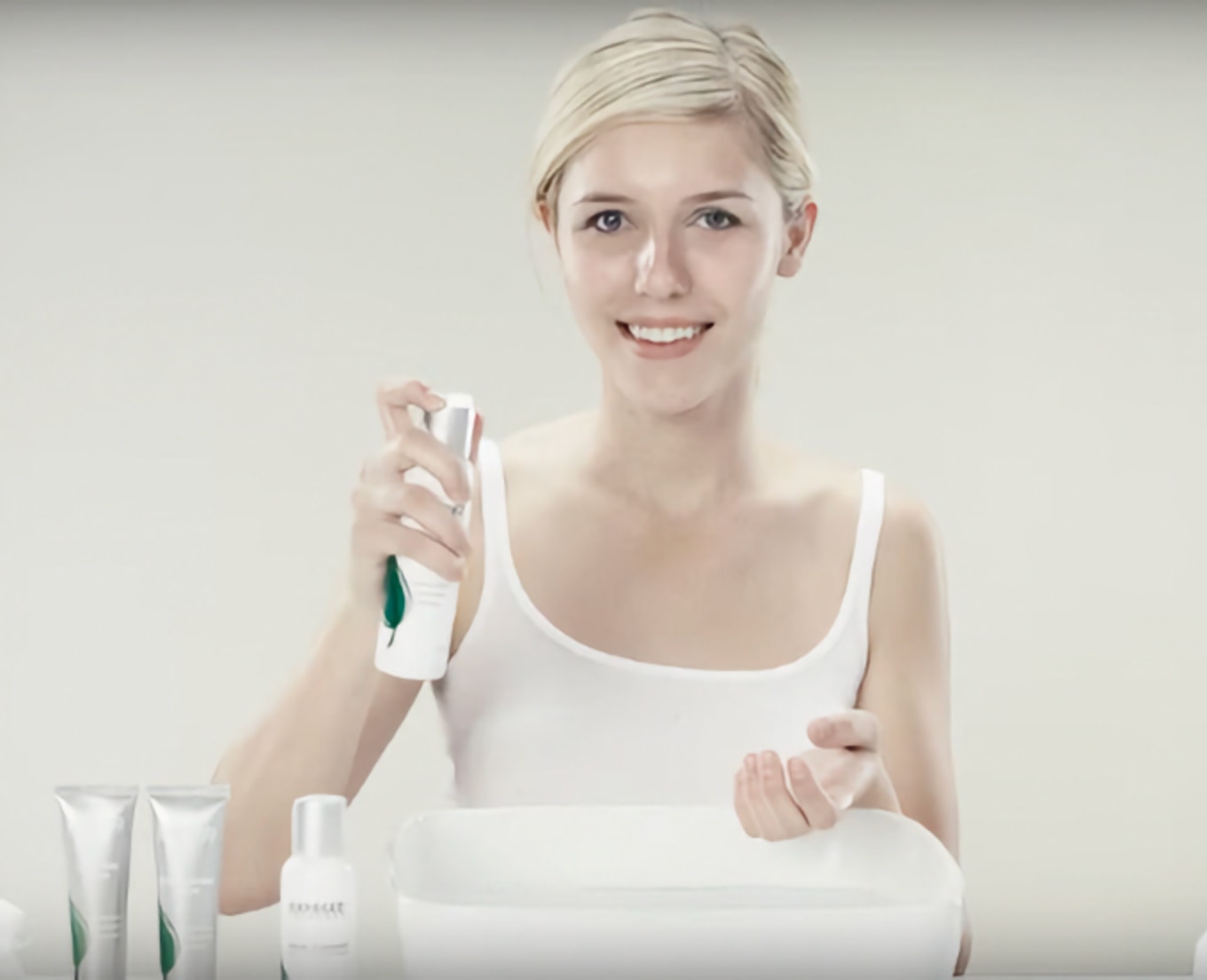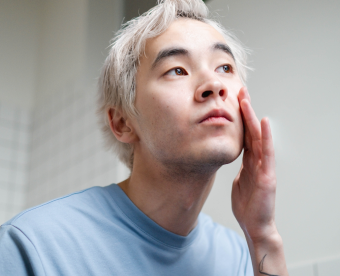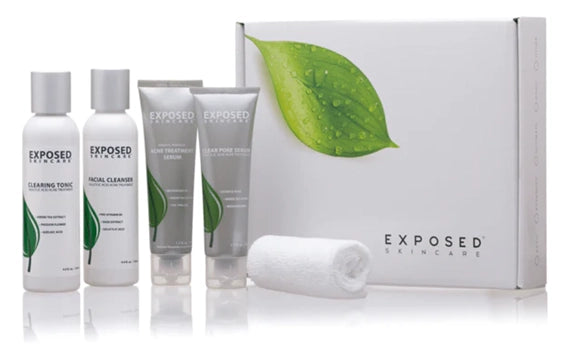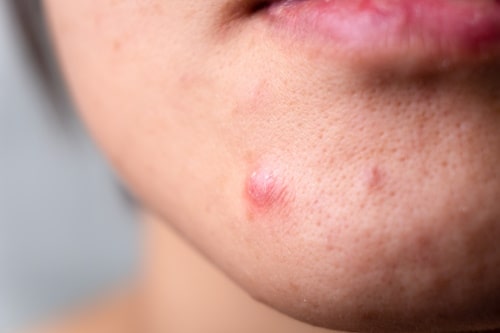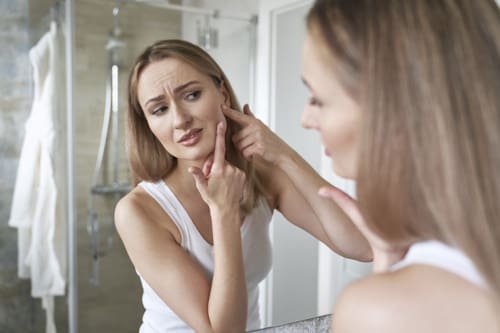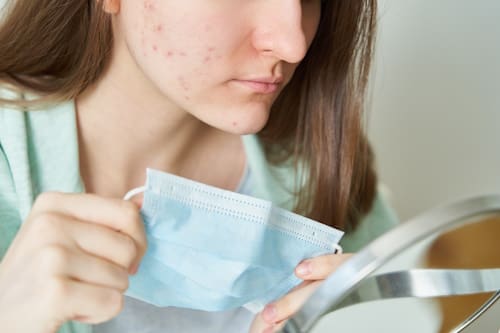Every so often, unexpected bumps show up on your skin, wreaking havoc on your smooth, clear face. This foe is stubborn, relentless, and distinctively different from regular acne - it's fungal acne.
Officially known as Malassezia or Pityrosporum folliculitis, fungal acne isn't "acne" in the traditional sense. This skin condition is a fungal infection that affects the hair follicles, which can be itchy and annoying.
Fortunately, getting rid of fungal acne on your forehead may be simpler than you think. This guide will help you identify, treat, and prevent this pesky skin issue.
Also read: How to choose the best acne treatment
Biggest Take-Aways:
- Fungal acne, though often mistaken for bacterial acne, is a distinct condition that requires targeted treatment strategies.
- Due to sweat and oil, the forehead is particularly susceptible to this type of acne.
- A regular skincare routine and lifestyle modifications are crucial in preventing and managing fungal acne.
- Products like Exposed Skin Care can offer a versatile and effective solution, making it a key ally in treating and preventing fungal acne.

Understanding Fungal Acne
What is Fungal Acne?
Fungal acne is often mistaken for acne vulgaris due to its similar appearance, manifesting as small, whitehead-like bumps on the skin. However, fungal acne is often itchy and typically concentrated in areas prone to sweating.
Also known as Malassezia or Pityrosporum folliculitis, fungal acne results from an overgrowth of yeast, specifically the Malassezia fungus, on your skin.
Unlike bacterial acne, which is caused by bacteria on your skin, fungal acne is triggered by yeast (a type of fungus). It thrives in an environment rich in oil, dead skin cells, and sweat, which explains why the forehead - a part of the face that can get pretty sweaty and oily - is a common target.
Fungal Acne vs. Regular Acne
Contrary to common belief, fungal acne isn't acne. It's often misdiagnosed as acne vulgaris, but there's a key distinction between regular acne and fungal acne. The culprit behind regular acne is usually bacteria called Propionibacterium acnes, while yeast on the skin causes fungal acne.
Regular acne happens due to excess oil production, blocked hair follicles, or hormonal changes. Conversely, an overgrowth of yeast in hair follicles causes fungal acne. The forehead is prone to fungal infections, and this overgrowth results in itchy, small bumps and worsening fungal acne if scratched.

Symptoms of Fungal Acne
Recognizing the signs of fungal acne is the first step to effective treatment. These include:
- Small, uniform, itchy bumps (folliculitis)
- Bumps filled with pus (whiteheads)
- Bumps appearing in areas often covered by clothes or prone to sweating, such as the forehead
- Bumps that get worse with antibiotic or oral acne treatments, as these can disrupt the skin's microbiome and allow for yeast overgrowth
How to Identify and Treat Fungal Acne on Your Forehead
Identifying Fungal Acne
To start the process of how to get rid of fungal acne on your forehead, you need to identify it correctly. Due to the likeness with bacterial acne, the right diagnosis and treatment often get delayed. Here's what fungal acne looks like:
- Monomorphic: The bumps are generally the same size.
- Itchiness: Fungal acne can be itchy, unlike common acne.
- Location: It appears mainly in areas prone to sweating, such as the forehead.

If you're experiencing these symptoms, you could be dealing with fungal acne.
Effective Treatment Options for Fungal Acne
Treatment for fungal acne can vary, depending on the severity. Here are a few ways to address the issue:
-
Topical Treatments: Over-the-counter (OTC) antifungal creams or lotions that contain active ingredients such as ketoconazole or clotrimazole can help.
-
Antifungal Shampoos: Products containing ketoconazole, selenium sulfide, or zinc pyrithione are particularly effective when left on the affected area for a few minutes before rinsing.
-
Oral Antifungal Medication: For severe cases, oral antifungal medication may be prescribed by a doctor, but remember to avoid antibiotics, as they might make fungal acne worse.
-
Natural Remedies: Some people have found success using tea tree oil, which has natural antifungal properties. However, be cautious and always dilute it before use.

Preventing Fungal Acne: Skincare and Lifestyle Changes
Just treating fungal acne isn't enough. Learning how to prevent fungal acne is equally essential. Below are a few tips:
-
Maintain a consistent skincare routine: Keeping your skin clean is crucial. Use products that help control oil production and limit yeast growth.
-
Avoid heavy and oily skincare products: These can trap yeast and encourage their growth. Opt for non-comedogenic and oil-free products.
-
Change your clothes after sweating: Yeast thrives in a sweaty environment. Therefore, after a workout or a hot day, change your clothes and wash the sweaty areas as soon as possible.
-
Eat a balanced diet: Eating a diet rich in fruits, vegetables, and lean proteins can contribute to overall skin health.
The Benefits of Using Exposed Skin Care
Exposed Skin Care is a stellar ally in managing various types of acne, including "fungal acne" or Malassezia folliculitis.
Here are some reasons Exposed Skin Care if great for fungal acne:
- Effective against fungal growth: The ingredients in Exposed Skin Care disrupt the fungal cell membrane, hindering yeast growth on your skin and reducing the likelihood of developing fungal acne.
- Promotes healthy skin: Regular use can help balance your skin type, especially for oily skin where yeast may thrive. It's an excellent addition to your daily skincare routine.
- Versatile treatment: Whether it's fungal acne on your face or fungal folliculitis, Exposed Skin Care can effectively treat your fungal acne.
- Preventive measure: Using this product reduces the chances of getting fungal acne thanks to its antifungal properties.
Remember, maintaining cleanliness is crucial, and donning clean clothes can prevent fungal infection of the hair follicles - a leading cause of fungal acne. Like regular acne, fungal acne can cause distress, but you can keep your skin healthy and clear with proper treatment, such as Exposed Skin Care, and good hygiene habits.
Conclusion
Successfully navigating the journey of managing and treating "fungal acne" or Malassezia folliculitis entails a comprehensive understanding of the condition, its causes, and how to apply effective antifungal treatments.
With a mindful skincare routine and lifestyle changes, you can combat the outbreak of these stubborn bumps and prevent further instances. Products like Exposed Skin Care, designed specifically to address various acne issues, can play a vital role in your skincare arsenal.
By integrating it into your daily skincare routine, you can effectively combat fungal acne on the face and promote the health of your specific skin type. Remember, fungal acne is often treated by addressing the symptoms and the underlying causes, which frequently include excessive sweat and oil.
Ensuring hygiene, like changing clothes without letting them stay damp or dirty for long periods, is equally important. With the right knowledge, skincare regimen, and patience, you can overcome the issues caused by fungal acne, paving the way for healthier, clearer skin.
FAQs
What causes fungal acne on the forehead?
Fungal acne is caused by an overgrowth of yeast, specifically the Malassezia fungus, in the hair follicles. This overgrowth is often triggered by factors such as a sweaty and oily environment, immune suppression, or the misuse of antibiotics.
How is fungal acne diagnosed?
Fungal acne is often diagnosed based on its appearance and symptoms, including itchiness, uniform bump size, and location on the body. However, a definite diagnosis usually requires a microscopic examination or a fungus culture.
Can I get rid of fungal acne without seeing a dermatologist?
While severe cases of fungal acne may require a visit to a doctor, mild to moderate instances can often be managed at home using over-the-counter topical treatments, antifungal shampoos, or lifestyle changes. However, if symptoms persist, you may need professional medical advice.
How long does it take to get rid of fungal acne?
The duration to completely get rid of fungal acne can vary from person to person, based on the severity of the condition and the effectiveness of the treatment. Generally, it may take a few weeks to several months to see significant improvement.
How can I change my skincare routine to prevent fungal acne?
Adopt a skincare routine that helps control oil production and minimizes sweat, as these conditions encourage yeast growth. Avoid heavy and oily skincare products, and opt for non-comedogenic and oil-free options.

